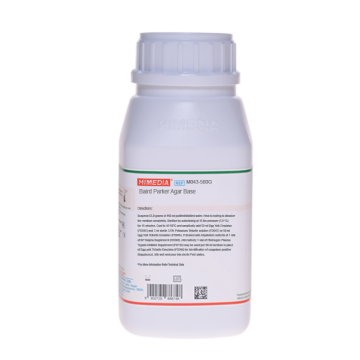 Your enquiry has been submitted
Your enquiry has been submitted
Tryptone Soya Broth w/ NaCl and 1% Sodium Pyruvate
Intended Use
Recommended for enumeration of Staphylococcus aureus in dairy products by MPN technique.
Composition**
| Ingredients | g/L |
|---|---|
| Tryptone | 17.000 |
| Soya peptone | 3.000 |
| Dextrose (Glucose) | 2.500 |
| Sodium chloride | 100.000 |
| Dipotassium hydrogen phosphate | 2.500 |
| Sodium pyruvate | 10.000 |
Final pH (at 25°C): 7.3±0.2
**Formula adjusted, standardized to suit performance parameters
Directions
Suspend 135.0 grams in 1000 ml purified/distilled water.Heat if necessary to dissolve the medium completely. Dispense into tubes or flasks as desired. Sterilize by autoclaving at 15 lbs pressure (121°C) for 15 minutes.
Principle And Interpretation
Staphylococcal food poisoning ranks as one of the most prevalent causes of gastroenteritis worldwide. Staphylococci ferment glucose to produce acid from glucose. Tryptone Soya Broth with 10% sodium chloride and 1% sodium pyruvate is used for enumeration of Staphylococcus aureus in dairy products (1, 2) and is recommended for enumeration by MPN technique.
Tryptone and soya peptone provide essential nutrients. Dextrose serves as an energy source. Sodium pyruvate protects injured cells, helps recovery and also enhances growth of S. aureus. Many other bacteria except staphylococci are inhibited by 10% sodium chloride (3).
Type of specimen
Dairy samples
Specimen Collection and Handling
For MPN Technique: Inoculate 3 tubes of Tryptone Soya Broth w/ 10% NaCl and 1% sodium pyruvate (M1229) of each test dilution with 1 ml aliquots of decimal dilutions of sample. Incubate at 35-37°C for 48 hours. Following incubation, transfer a loopful from each positive growth tube to Baird-Parker Agar (M043) plates. Colonies of S. aureus on Baird Parker Agar are typically circular, smooth, convex, moist, 2-3 mm in diameter, grey-black to jet black and surrounded by an opaque zone. After use, contaminated materials must be sterilized by autoclaving before discarding.
Warning and Precautions :
Read the label before opening the container. Wear protective gloves/protective clothing/eye protection/ face protection. Follow good microbiological lab practices while handling specimens and culture. Standard precautions as per established guidelines should be followed while handling specimens. Safety guidelines may be referred in individual safety data sheets.
Limitations :
- Further biochemical and serological tests must be carried out for further identification.
Performance and Evaluation
Performance of the medium is expected when used as per the direction on the label within the expiry period when stored at recommended temperature.
Quality Control
Appearance Cream to yellow homogeneous free flowing powder
Colour and Clarity of prepared medium Light yellow coloured clear solution without any precipitate
Reaction
Reaction of 13.5% w/v aqueous solution at 25°C. pH: 7.3±0.2
pH
7.10-7.50
Cultural Response
Cultural characteristics observed after an incubation at 35-37°C for 18-48 hours.
| Organism | Inoculum (CFU) | Growth |
|---|---|---|
| ** Bacillus spizizenii ATCC 6633 (00003*) | >=104 | inhibited |
| Staphylococcus aureus ATCC 25923 subsp. aureus (00034*) | 50-100 | luxuriant |
| Escherichia coli ATCC 25922 (00013*) | >=104 | inhibited |
Key: *Corresponding WDCM numbers. **Formerly known as Bacillus subtilis subsp. spizizenii
Storage and Shelf Life
Store between 10-30°C in a tightly closed container and the prepared medium at 15-30°C. Use before expiry date on the label. On opening, product should be properly stored dry, after tightly capping the bottle in order to prevent lump formation due to the hygroscopic nature of the product. Improper storage of the product may lead to lump formation. Store in dry ventilated area protected from extremes of temperature and sources of ignition. Seal the container tightly after use. Product performance is best if used within stated expiry period.
Disposal
User must ensure safe disposal by autoclaving and/or incineration of used or unusable preparations of this product. Follow established laboratory procedures in disposing of infectious materials and material that comes into contact with sample must be decontaminated and disposed of in accordance with current laboratory techniques (4,5).
Reference
- AOAC, 2000, Official Method 987.09, Staphylococcus aureus in Foods, J. Assn. Off. Anal. Chem. 17:52.
- Wehr H. M. and Frank J. H., 2004, Standard Methods for the Microbiological Examination of Dairy Products, 17th Ed., APHA Inc., Washington, D.C.
- Chapman G. H, 1945, J. Bacteriol., 50:201.
- Isenberg, H.D. Clinical Microbiology Procedures Handbook 2nd Edition.
- Jorgensen, J.H., Pfaller, M.A., Carroll, K.C., Funke, G., Landry, M.L., Richter, S.S and Warnock., D.W. (2015) Manual of Clinical Microbiology, 11th Edition. Vol. 1.
Revision :02/2024
| Product Name | Tryptone Soya Broth w/ NaCl and 1% Sodium Pyruvate |
|---|---|
| SKU | M1229 |
| Product Type | Regular |
| Physical Form | Powder |
| Origin | Animal |
| Packaging type | HDPE |
| References | 1. AOAC, 2000, Official Method 987.09, Staphylococcus aureus in Foods, J. Assn. Off. Anal. Chem. 17:52. |
| Customized Product Available | No |









